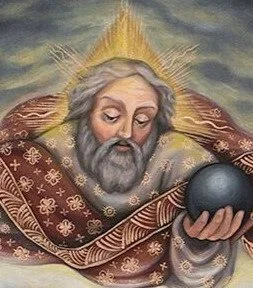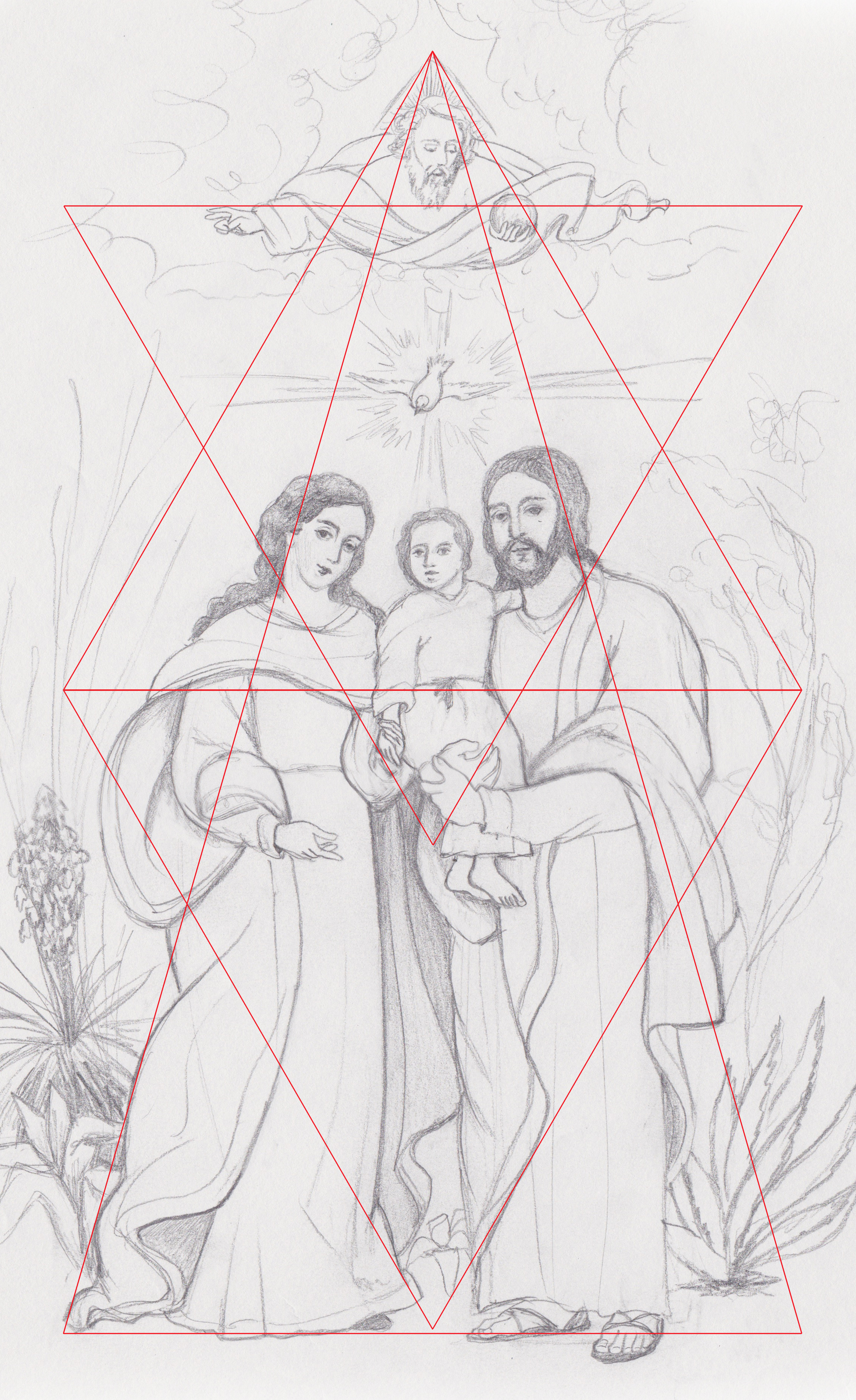In the past year we encountered thousands of people at our booths at both the National Eucharistic Congress in Indianapolis and SEEK in Salt Lake City. Displaying a large-scale canvas giclee print of The Holy Family, our booth drew in people who stopped in their tracks to stare at the image, seemingly attracted by some unseen force. Created using divine proportions and rich traditional symbolism, this artwork captivated viewers, not because of its overt emotional expressiveness or provocative style, but because of the sacramental power of sacred art, which strives to reveal the invisible reality of heaven.
Sacred art as a genre is not meant to merely entertain the viewer or manipulate our emotions to feel more spiritual – it is intended to reveal the invisible reality of heaven, the objective truths of our faith and the mind of God. How we encounter that truth is up to us, whether we receive or reject it. Sacred art is like a visual poem, using symbolic language to help the viewer discover deeper mysteries. And like poetry, which is not meant for quick consumption, one must spend time with it in contemplation to allow the layers of meaning to unfold.
Here, we examine in more depth the main themes and rich symbolism explored in this work.
Sacred art is intended to reveal the invisible reality of heaven, the objective truths of our faith and the mind of God.
FIGURES IN THE HOLY FAMILY
The Double Trinity
This image depicts a foundational and profound mystery of our faith – the family.
God Himself – Father, Son and Holy Spirit – is Himself, a Family. Earthly families – husband, wife, and any children that God gives them – is a living image or ‘icon’ of the Blessed Trinity. Therefore, this image includes a portrait of both the heavenly Family as well as a portrait of the human family – represented by the Holy Family of Joseph, Mary and Jesus. Combining the Holy Trinity and the Holy Family in a single image is known as the “double trinity” in the sacred art of the Spanish Colonial period of Latin America.
Joseph, Mary and Jesus
The Holy Family is shown as strong but warm and approachable, a healing image for a culture where the traditional family has been relentlessly attacked and degraded. Jesus is the center of His earthly family, a stabilizing force that unites its members. He holds onto both Mary and Joseph, and it is only in and through Him that they are united. Mary and Joseph do not physically touch, which further reveals the truth of Mary’s perpetual virginity. St. Joseph holding Jesus with his large, strong carpenter hands presents an image of a strong, fully present and faithful follower of Christ, in close relationship with Him.
Mary’s Garments
This image was commissioned by the Diocese of Phoenix for its 50th Anniversary in 2019. Because Our Lady of Guadalupe is the patroness of the diocese, Mary’s garments reflect the patterns visible on the Divine Image of Our Lady of Guadalupe that appeared on Saint Juan Diego’s Tilma in 1531. The original flower pattern in Mary’s gown contains a whole narrative in the pictorial Aztec language that the Aztec people of the time would have read like a book. Squash blossom flowers reveal stylized human faces, with stems that grow out of a field of deep celestial blue. This tells of the value and dignity of the human person, created from a divine source for a holy purpose, with an eternal soul. In a few short decades after Our Lady of Guadalupe appeared, all human sacrifice in the Aztec temples had ceased because of this powerful, miraculous image.
Joseph’s Garments
On his cloak, Joseph, from the Tribe of Judah, bears the symbol of the Lion, similar in style and derived from the flower of Mary’s tunic. His outer cloak is wrapped protectively around his inner tunic, which shows Mary’s flower, the tender fleur de lis, or lily. In this symbolic language, Joseph is shown as the protector of Mary and the family.
Jesus and the Father’s Garments
On the original gown of Our Lady of Guadalupe, there is a single four-petaled flower over her womb. This was understood to represent divinity, the ‘God Flower’ to the Aztecs - and signified the Christ Child in Mary’s womb. Therefore, in this image of The Holy Family, her gown no longer bears that flower. Rather, it is shown as the pattern on Christ’s garment, and this same flower is mirrored with more embellishment in God the Father’s cloak.
THE LANDSCAPE
The theme of this painting is the familiar story of the Holy Family and their Flight into Egypt. Native desert plants of the Arizona southwest comprise the landscape, with the intent of drawing the people for whom the painting was commissioned from their current environment into the eternal reality. As I worked on this piece, I considered the plight of this family; how incongruous that they are exiled, fleeing for their lives, and yet, they are so serene! How can this be? As one viewer noted, “You don’t know whether the storm clouds are gathering or dissipating, but the Holy Family looks out at us with peaceful perseverance and strength.” Perhaps this image is a reminder that the Holy Family also once physically walked the treacherous road of life, and they are now present to us, as we find ourselves in painful or difficult circumstances. We are all exiles from our original Eden. They also mirror us, showing us that in the storms of this world, we have an eternal destiny. They show us how to walk the path laid out before us in faith, and they accompany us on our way.
THE STRUCTURE
The underlying structure of the image contains within it the divine proportion, a prominently repeating ratio in nature (God’s creation) and also used in and art, science and math from the time of the ancient Egyptians to present day architects. The divine proportions are known to present a perfectly aesthetic composition communicating cohesion and completeness. In this example, the upper half of the composition unites both the heavenly Family and earthly family within the Star of David and also contains the mirrored construct of two isosolese triangles, suggesting the earthly Family is an icon of the heavenly family.
The underlying composition follows layers of symbolic geometric constructs in multiple directions as noted by the multiple triangle overlay.
The vertical center of the painting is occupied by the three Divine Persons of the Blessed Trinity - God the Father, the Holy Spirit, and Christ. The human, Holy Family occupies the horizontal axis of the painting, with The Christ Child in the center of both families – uniting the Divine and the human within a cruciform framework.
VISIO DIVINA
The layered symbolism shared here can provide a richer foundation to take to prayer with the image in the practice of “Visio Divina” or “Divine Seeing”. One might consider sitting with this image and reflecting on one or more of the following questions:
What does this image communicate to me about the nature of God? Do I sense an invitation from God in some way when viewing this image?
What emotions do I experience when gazing at this image? Where might I imagine myself in the image?
What does this image tell me about the “desert” experiences in my own life? Are my storm clouds gathering or dissipating, and how can the Holy Family speak into this?
In the place we find ourselves, are we holding on to Christ, centering Him in our lives and our own families? (See a reflection of Bishop John Dolan on the Holy Family here.)
Finally - Here we share an article by Bishop Emeritus Thomas Olmsted on the family for additional reflection.








